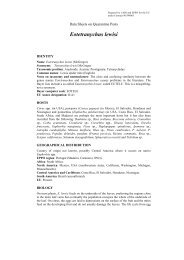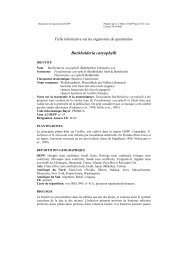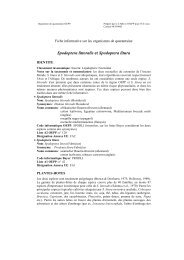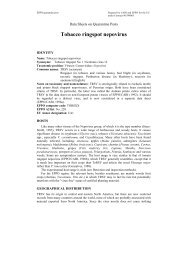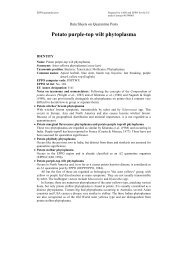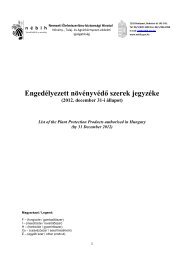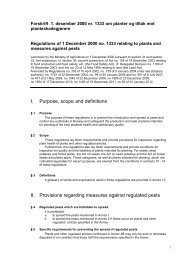Phialophora cinerescens - European and Mediterranean Plant ...
Phialophora cinerescens - European and Mediterranean Plant ...
Phialophora cinerescens - European and Mediterranean Plant ...
You also want an ePaper? Increase the reach of your titles
YUMPU automatically turns print PDFs into web optimized ePapers that Google loves.
EPPO quarantine pest Prepared by CABI <strong>and</strong> EPPO for the EU<br />
under Contract 90/399003<br />
IDENTITY<br />
Data Sheets on Quarantine Pests<br />
<strong>Phialophora</strong> <strong>cinerescens</strong><br />
Name: <strong>Phialophora</strong> <strong>cinerescens</strong> (Wollenweber) van Beyma<br />
Synonyms: Verticillium <strong>cinerescens</strong> Wollenweber<br />
Taxonomic position: Fungi: Ascomycetes (probable anamorph of Hypocreales)<br />
Common names: <strong>Phialophora</strong> wilt (English)<br />
Maladie bleue, verticilliose (French)<br />
Welkekrankheit der Edelnelke (German)<br />
Lakastumistauti (Finnish)<br />
Nejlikvissnesjuka (Swedish)<br />
Nellikevifteskimmel (Danish)<br />
Nellikvisnesjuke (Norwegian)<br />
Bayer computer code: PHIACI<br />
EPPO A2 list: No. 77<br />
EU Annex designation: II/A2<br />
HOSTS<br />
Carnations are the main host. A number of caryophyllaceous garden plants are secondary<br />
hosts. Glasshouse carnations are the main crop at risk in all parts of the EPPO region.<br />
GEOGRAPHICAL DISTRIBUTION<br />
P. <strong>cinerescens</strong> is an indigenous <strong>European</strong> species.<br />
EPPO region: Belgium, Bulgaria, Czech Republic (intercepted only), France, Germany,<br />
Greece, Hungary, Irel<strong>and</strong>, Italy, Latvia, Lithuania, Netherl<strong>and</strong>s, Norway, Pol<strong>and</strong>, Romania,<br />
Russia (<strong>European</strong>), Slovenia, Spain, UK, Yugoslavia.<br />
Asia: China.<br />
South America: Colombia.<br />
North America: Canada (Ontario), USA (Colorado, Oregon).<br />
EU: Present.<br />
BIOLOGY<br />
The fungus can survive saprophytically for many years in soil. In the Netherl<strong>and</strong>s, in a<br />
glasshouse where the disease had occurred, but where carnations had not been grown for<br />
13 years, plants were attacked by P. <strong>cinerescens</strong> following planting. It is reported that the<br />
spores remain viable in surface water for about 8 weeks.<br />
Sporulation is up to maximum at temperatures around 18-23°C (10-28°C); at low<br />
temperatures, more spores are produced but in a longer time, <strong>and</strong> the spores tend to be<br />
larger than those produced at higher temperatures. Disease development is usually greater<br />
from November to May, after which it is arrested by high summer temperatures.
2 <strong>Phialophora</strong> <strong>cinerescens</strong><br />
Infection experiments suggest that spores of P. <strong>cinerescens</strong> enter the xylem vessels<br />
directly through wounds on the roots. The fungus becomes widespread in the plant, which<br />
may or may not show visible signs of infection. The incubation period is comparatively<br />
long, varying between 45 <strong>and</strong> 106 days for susceptible <strong>and</strong> resistant cultivars, respectively.<br />
For more information, see Wickens (1935), Hellmers (1958), Hantschke (1961), Moreau<br />
(1970), Hawksworth & Gibson (1976).<br />
DETECTION AND IDENTIFICATION<br />
Symptoms<br />
Following infection, leaves <strong>and</strong> stems become bluish-grey in colour. Subsequently, there is<br />
a rapid wilt of the whole plant (without rotting). The root system remains intact <strong>and</strong><br />
apparently unaffected. Peeling off the cortex or taking longitudinal or transverse sections of<br />
the stem will reveal a browning of the vascular zone. This discoloration tends to be<br />
localized to a number of small groups of vessels <strong>and</strong> tracheids, so appearing as a series of<br />
longitudinal brown stripes when the cortex is removed. There is no extensive rotting of the<br />
pith or cortex. Another vascular wilt pathogen, Fusarium oxysporum f.sp. dianthi, which<br />
induces a similar disease syndrome, may be simultaneously present or be the causal<br />
organism. The only method of differentiating the two fungi is by examining pure culture<br />
isolations. For more information, see Wickens (1935), Hellmers (1958), Hantschke (1961),<br />
Tramier (1967), Hawksworth & Gibson (1976).<br />
Morphology<br />
Conidiophores simple or branched, septate, hyaline becoming pale-brown with age,<br />
smooth-walled, mainly 8-20 x 2-3 µm. Phialides flask-shaped <strong>and</strong> arranged in densely<br />
verticillate bunches on the conidiophores, 8-12 x 2.5-3.5 µm, ending in a darker, very short<br />
but distinct collarette with a minute flaring margin. Conidia aseptate, hyaline to palebrown,<br />
cylindrical, ovoid or ellipsoidal with slightly apiculate basal ends, smooth-walled<br />
<strong>and</strong> containing one to two oil drops, 3-6 x 1.5-2.6 µm. Hyphae septate, hyaline to palebrown,<br />
1-3 µm wide; on ageing, frequently develop irregularly swollen cells covered with<br />
flat warts <strong>and</strong> up to 6 µm wide. These cells have been mistakenly identified as<br />
chlamydospores.<br />
Colonies on 2% malt extract agar, characteristically woolly, light mineral-grey in the<br />
centre, merging via smoke-grey <strong>and</strong> deep slate-olive into a 0.7-cm broad hyaline margin of<br />
appressed mycelium.<br />
Chlamydospores <strong>and</strong> sclerotia are absent.<br />
Detection <strong>and</strong> inspection methods<br />
There are various means of testing cuttings for vascular pathogens, based principally on<br />
isolating from or incubating stem sections (Hellmers, 1958; Jenkins, 1958). A rapid <strong>and</strong><br />
early diagnosis can be achieved through fluorescence microscopy which shows infected<br />
areas of P. <strong>cinerescens</strong> as bright fluorescent spots at the level of the woody vessels<br />
(Bonifacio & Rumine, 1984).<br />
MEANS OF MOVEMENTAND DISPERSAL<br />
As a soil-borne pathogen, P. <strong>cinerescens</strong> has an extremely limited potential for natural<br />
spread. The main pathway for spread is international trade in carnation cuttings.
<strong>Phialophora</strong> <strong>cinerescens</strong><br />
PEST SIGNIFICANCE<br />
Economic impact<br />
Following its first description in France around 1950, P. <strong>cinerescens</strong> has spread throughout<br />
areas of <strong>European</strong> carnation production <strong>and</strong> is now considered one of the most serious<br />
pathogens of this crop. The disease is of great economic importance in many carnationcultivating<br />
areas of the EPPO region. In Colombia, this fungus is regarded as one of the<br />
two most important pathogens of carnations; the other is Fusarium oxysporum f.sp. dianthi<br />
(Arbelaez, 1988a).<br />
Since cuttings may harbour latent infections, this fungus is easily introduced into new<br />
areas <strong>and</strong>, once established, it is extremely difficult to eradicate. Given the relatively<br />
constant <strong>and</strong> favourable environment of a glasshouse, carnation wilt has great potential for<br />
rapid spread, with resultant heavy losses.<br />
Control<br />
Direct control is difficult, but soil sterilization by heating (over 66°C) or fumigation<br />
(methyl bromide at 100 g/m 3 ), <strong>and</strong> fungicidal root dips have given promising results<br />
(Schol-Schwarz, 1970). However, systemic fungicides such as benomyl, carbendazim,<br />
thiophanate-methyl <strong>and</strong> thiabendazole have completely failed to control the disease<br />
(Rumine & Parrini, 1982; Arbelaez, 1988b). In practice, the disease is mainly controlled by<br />
use of disease-free planting material, which may be obtained from stem-tip cuttings of<br />
infected plants.<br />
Phytosanitary risk<br />
P. <strong>cinerescens</strong> is considered as an EPPO A2 quarantine organism (OEPP/EPPO, 1982) <strong>and</strong><br />
is also of quarantine significance for NAPPO. Its further spread within the Euro-<br />
<strong>Mediterranean</strong> region would cause considerable economic losses. However, EPPO now<br />
recommends the application of a nuclear-stock certification scheme for carnations<br />
(OEPP/EPPO, 1991), <strong>and</strong> this may lead EPPO to reconsider the quarantine-pest status of P.<br />
<strong>cinerescens</strong> (see below).<br />
PHYTOSANITARY MEASURES<br />
In countries where P. <strong>cinerescens</strong> occurs, growing season inspections should be carried out<br />
<strong>and</strong> cuttings should be taken from separately grown mother plants which have been tested<br />
by an EPPO-approved method within the last 2 years (OEPP/EPPO, 1990). Suspected<br />
infected plants should be sectioned to see if there is any vascular discoloration. Isolation of<br />
the causal fungus may be necessary for correct identification. The integration of such<br />
measures into a general nuclear-stock certification scheme, as already proposed<br />
(OEPP/EPPO, 1991), may finally be the most satisfactory phytosanitary measure.<br />
BIBLIOGRAPHY<br />
Arbelaez, G. (1988a) Fungal <strong>and</strong> bacterial diseases on carnation in Colombia. Acta Horticulturae No.<br />
216, pp. 151-157.<br />
Arbelaez, G. (1988b) Control of Fusarium oxysporium <strong>and</strong> <strong>Phialophora</strong> <strong>cinerescens</strong> on carnation by<br />
combined soil treatment <strong>and</strong> application of antagonists. Acta Horticulturae No. 216, pp. 77-84.<br />
Bonifacio, A.; Rumine, P. (1984) [Use of the fluorescence microscope in the diagnosis of vascular<br />
diseases of carnation]. Informatore Fitopatologico 34, 43-44.<br />
Garibaldi, A. (1969) [Influence of several factors on symptom expression in phialophora wilt of<br />
carnation]. Phytopathologia Mediterranea 8, 19-27.<br />
Hantschke, D. (1961) [Studies on wilt diseases of carnation in Germany, <strong>and</strong> the causal pathogens].<br />
Phytopathologische Zeitschrift 43, 113-168.<br />
3
4 <strong>Phialophora</strong> <strong>cinerescens</strong><br />
Hawksworth, D.L.; Gibson, I.A.S. (1976) <strong>Phialophora</strong> <strong>cinerescens</strong>. CMI Descriptions of Pathogenic<br />
Fungi <strong>and</strong> Bacteria No. 503. CAB International, Wallingford, UK.<br />
Hellmers, E. (1958) Four wilt diseases of perpetual-flowering carnations in Denmark. Dansk Botanisk<br />
Arkiv 18, 1-200.<br />
Jenkins, J.E.E. (1958) Methods for the detection of vascular wilt pathogens in carnation cuttings.<br />
<strong>Plant</strong> Pathology 8, 23.<br />
Moreau, M. (1970) La verticilliose de l'oeillet: un modèle intéressant pour aborder les rapports hôteparasite<br />
dans les maladies vasculaires. Horticulture Française 1, 19-28.<br />
OEPP/EPPO (1982) Data sheets on quarantine organisms No. 77, <strong>Phialophora</strong> <strong>cinerescens</strong>. Bulletin<br />
OEPP/EPPO Bulletin 12 (1).<br />
OEPP/EPPO (1990) Specific quarantine requirements. EPPO Technical Documents No. 1008.<br />
OEPP/EPPO (1991) Certification scheme. Pathogen-tested material of carnation. Bulletin<br />
OEPP/EPPO Bulletin 21, 270-290.<br />
Rumine, P.; Parrini, C. (1982) [The results of experiments on the control of <strong>Phialophora</strong> <strong>cinerescens</strong><br />
with benzimidazoles in the Pescia region]. Annali dell'Istituto Sperimentale per la Floricoltura 13,<br />
79-91.<br />
Schol-Schwarz, M.B. (1970) Revision of the genus <strong>Phialophora</strong> (Moniliales). Persoonia 6, 59-94.<br />
Tramier, R. (1967) Les principales maladies de l'oeillet. Bulletin Technique d'Information No. 217.<br />
Wickens, G.M. (1935) Wilt, stem rot <strong>and</strong> dieback of the perpetual-flowering carnation. Annals of<br />
Applied Biology 22, 630-683.



